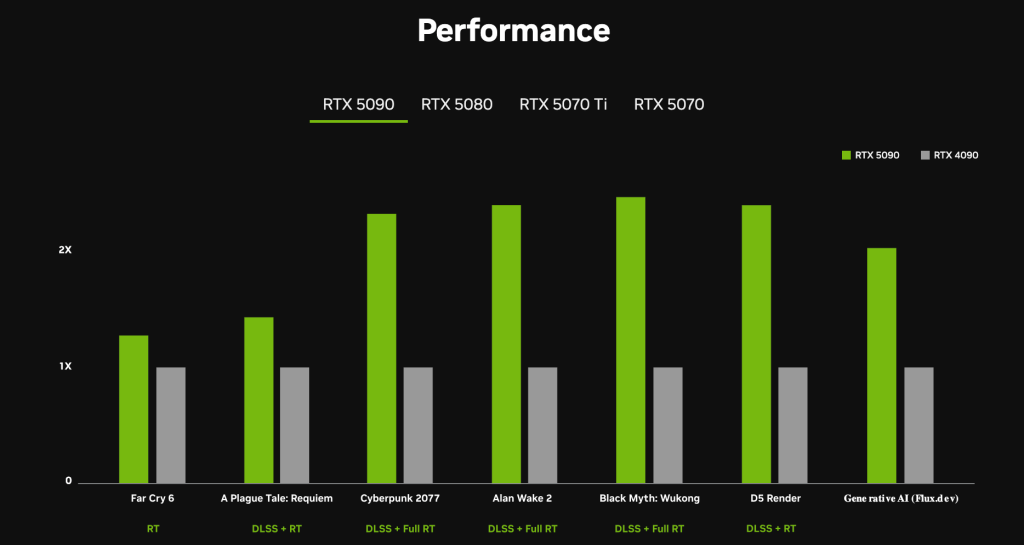After a longer-than-usual wait, Nvidia finally unveiled its highly anticipated GeForce RTX 50 Series graphics cards at CES 2025. The RTX 4000 series had an unusually long lifespan, initially launching in late 2022, and the industry expected the next generation sooner. Nvidia broke with tradition, extending the wait several months, leaving enthusiasts eager for the latest advancements. But was it worth the wait? Let’s dive in.
The Star of the Show: GeForce RTX 5090
Nvidia CEO Jensen Huang touted the RTX 50 series as the most significant advancement in computer graphics since programmable shading’s introduction 25 years prior. The star of the show, the GeForce RTX 5090, builds upon the already powerful RTX 4090, promising a significant performance leap. While the RTX 5090 carries a hefty price tag of $1,999 (a $400 increase over the RTX 4090’s launch price), the performance gains, fueled by the new Blackwell architecture, are substantial. Nvidia claims double the performance of the RTX 4090.
More Than Just the Flagship: A Look at the Entire Lineup
The RTX 50 series isn’t just about the top-tier card. Nvidia also revealed the RTX 5080, RTX 5070 Ti, and RTX 5070, each offering compelling performance-to-price ratios. Surprisingly, some cards in the 50 series are cheaper than their 40-series predecessors:
- RTX 5080: $200 less than the RTX 4080 at launch.
- RTX 5070 Ti: $50 less than the RTX 4070 Ti at launch.
- RTX 5070: A standout at $549, offering performance comparable to the RTX 4090, according to Nvidia. This aggressive pricing strategy could significantly impact competitors in the mid-range market.

Blackwell Architecture: The Engine Behind the Power
The performance boost isn’t just marketing hype. The RTX 50 series is powered by the new Blackwell architecture, featuring fifth-generation Tensor Cores for maximum AI performance and fourth-generation RT Cores for enhanced ray tracing capabilities. Key features include:
- Fifth-Gen Tensor Cores: Optimized for FP4 and DLSS 4.
- New Streaming Multiprocessors: Optimized for neural shaders.
- Fourth-Gen Ray Tracing Cores: Built for Mega Geometry.
- NVIDIA DLSS 4 with Multi-Frame Generation: Significantly boosts performance.
- NVIDIA Reflex 2 with Frame Warp: Minimizes latency for responsive gameplay.
- NVIDIA ACE: Enables realistic digital humans and AI assistants.
- NVIDIA Studio Tools: Enhances creative workflows.
- NVIDIA Broadcast and Ninth-Gen Encoder: Improves video quality.
Specifications and Founders Edition Design
The Founders Edition cards feature a redesigned dual-fan, dual-flow cooling system with a 3D vapor chamber. They support PCIe Gen 5 and DisplayPort 2.1b, capable of driving 8K displays at 165Hz. Surprisingly, the RTX 5090 Founders Edition is a dual-slot design, unlike the bulky RTX 4090, making it more compatible with smaller PC cases. Key specifications include:
- RTX 5090: 32GB GDDR7 memory, 1792GB/s memory bandwidth, 21,760 CUDA cores, 575W TDP (requires 1000W PSU).
- RTX 5080: 16GB GDDR7 memory, 960GB/s memory bandwidth, 10,752 CUDA cores, 360W TDP (requires 850W PSU).
- Image: Nvidia https://www.nvidia.com/en-us/geforce/graphics-cards/50-series/
The RTX 50 series is also making its way into laptops. The laptop versions will include the RTX 5090 with 24GB GDDR7, the RTX 5080 with 16GB GDDR7, the RTX 5070 Ti with 12GB GDDR7, and the RTX 5070 with 8GB GDDR7. Laptops featuring the RTX 50 series will be available from various manufacturers starting in March.

Conclusion:
The Nvidia GeForce RTX 50 Series represents a significant leap forward in graphics technology. While the flagship RTX 5090 commands a premium price, the performance gains are substantial, and the rest of the lineup offers compelling value. The Blackwell architecture, coupled with DLSS 4 and other advancements, makes the RTX 50 series a compelling upgrade for gamers and creators alike. The launch of the RTX 5090 and RTX 5080 is scheduled for January 30th. The market will be closely watching to see how this new generation impacts the competitive landscape.

